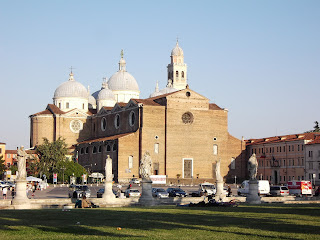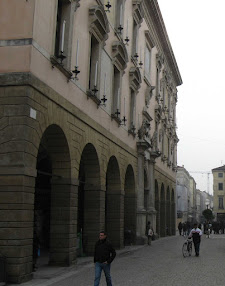Home of Andrea Mantegna’s famous frescoes
Near the
Giardino dell’Arena, where you can still see the remains of Padua’s Roman
Ampitheatre, stands the Chiesa degli Eremitani, or Church of the Hermits, one
of the most important churches in the city in the 14th century.
Padua's Chiesa degli Eremitani dates
back to the 13th century
The Church of
the Eremitani was built for Augustinian friars between 1260 and 1276 and
dedicated to the Saints Philip and James. The friars remained in the church and
adjoining monastery until 1806, when Padua was under Napoleonic rule and the
order was suppressed. The Church was reopened for services in 1808 and became a
parish church in 1817.
The church
has a plain façade and a loggia with a circular rose window above it. Inside, it
has a single nave with plain walls decorated with ochre and red bricks and a
vaulted wooden ceiling.
It houses
the ornate tombs of two lords of Padua, Jacopo II da Carrara and Ubertino da
Carrara, which were designed by Andriolo de Santi. The Musei Civici agli
Eremitani (Civic Museum) of Padua is now housed in the former Augustinian
monastery to the left of the church.
In the
Chapel of the Ovetari family, Andrea Mantegna began his artistic career at the
age of 17. One of the heaviest losses to Italy’s cultural heritage during World
War II occurred in 1944 in Padua when 15th century frescoes painted by Mantegna
were blown into thousands of pieces by bombs.
A raid on the city was carried out by the
Allies, hoping to hit Padua’s railway station and a building where the
occupying Germans had established their headquarters. But the bombs landed on
Padua’s Church of the Eremitani instead, causing devastating damage to the
beautiful frescoes created by the young Andrea Mantegna in one of the side
chapels.The damage the church suffered in
the air raid was considerable
It was one
of the worst blows inflicted on Italy’s art treasures during the war, as
Mantegna’s frescoes, which had been painted directly on to the walls of the
church, were considered a highly important work.
Andrea
Mantegna, who was born near Vicenza in 1431, had been commissioned to paint a
cycle of frescoes in the Ovetari Chapel, one of the side chapels in the Church
of the Eremitani.
The
commission marked the beginning of Mantegna’s artistic career when he started
work at the age of 17 in 1448. The artist was in his mid-20s by the time he had
finished the cycle in 1457, which showed scenes from the lives of Saint James
and Saint Christopher.
Tragically,
the German invading army had established their headquarters in Padua next to
the Church of the Eremitani. When the bombs fell in 1944, the chapel and the
wonderful frescoes were severely damaged. They were reduced to more than 88,000
separate pieces, which were later found mixed in with bit of plaster and bricks
on the ground.
Panels on the walls of the chapel
show how the frescoes looked
Fortunately, a detailed photographic survey of the work had been made previously and it was possible later to reconstruct the artist’s designs and recompose part of the cycle depicting the Martyrdom of Saint James.
Fragments that could be identified have been fixed to panels on the walls of the chapel where the frescoes were originally painted, which gives visitors some idea of how they looked before the church was bombed.
Other frescoes by Mantegna had been removed before the war to protect them from damp, and they remained undamaged and were eventually reinstated in the church.
In other
chapels in the Church, 14th century frescoes painted by Guarentio and Giusto
de’ Menabuoi miraculously survived.


.jpg)

.jpg)


.JPG)





